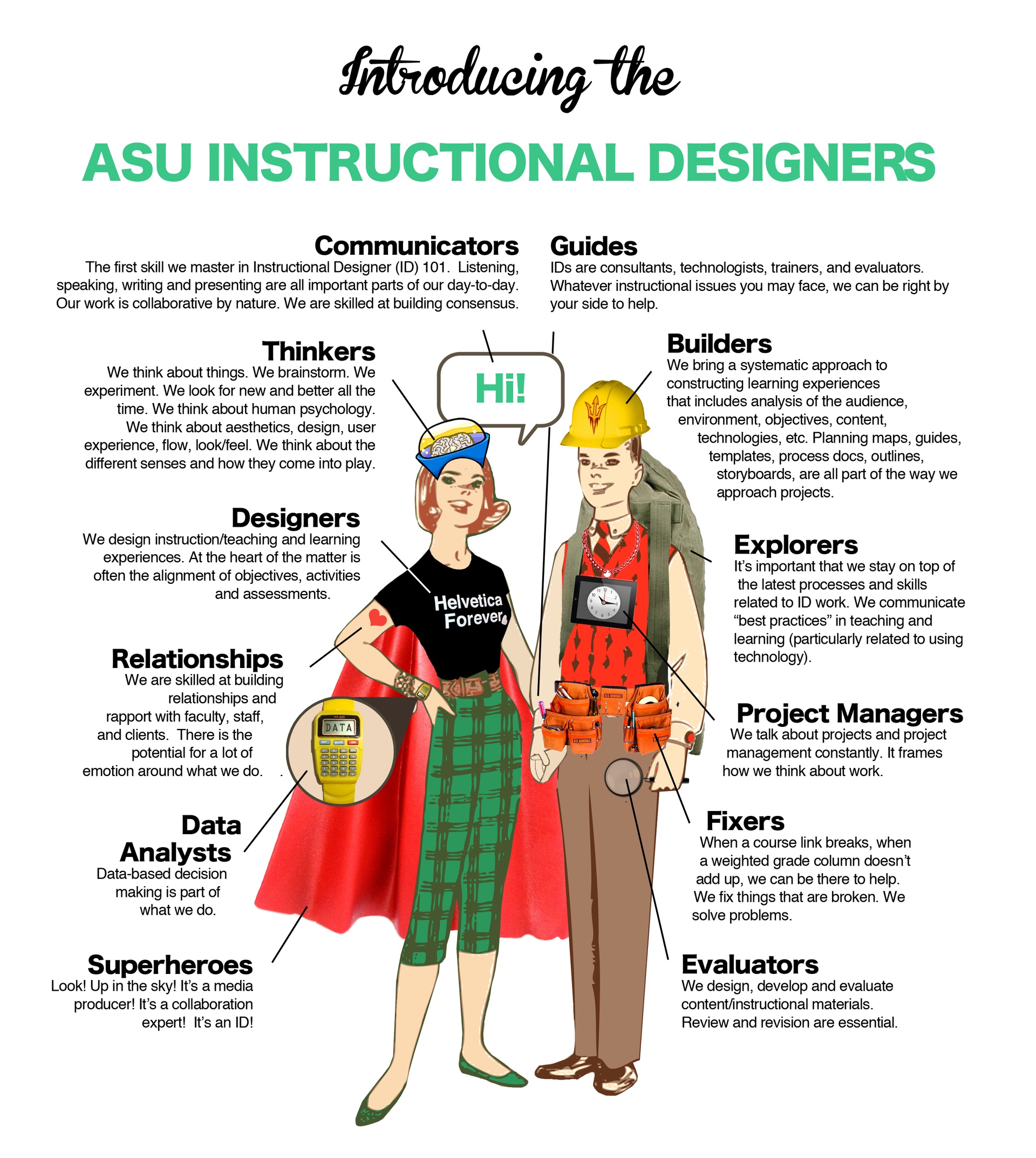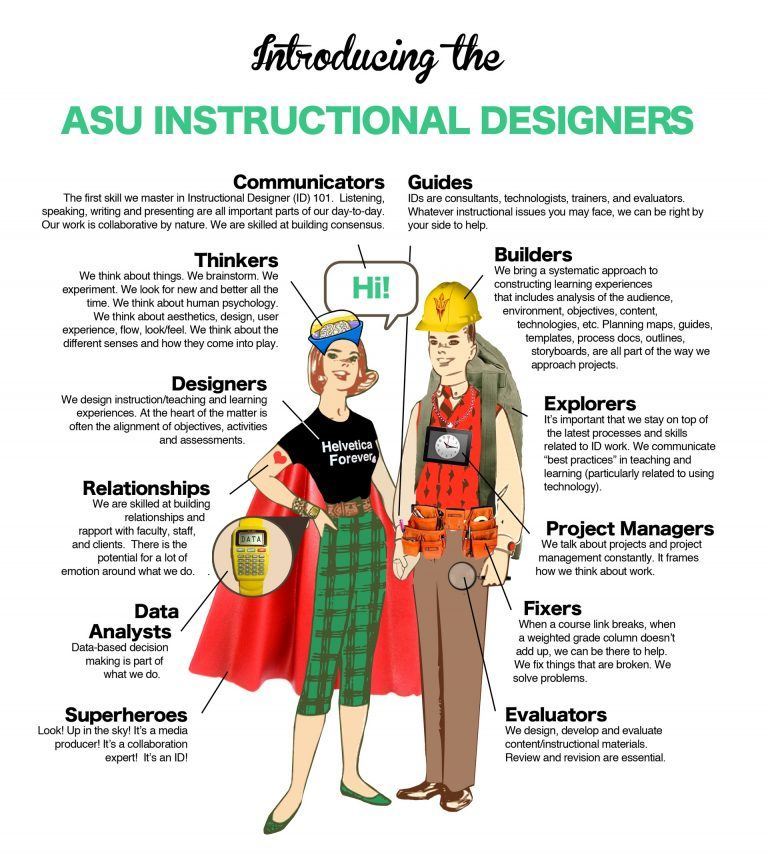Master of Education in Learning Design and Technology online USC Rossier School of Education
Table Of Content

While perhaps the most common design model, there are a number of weaknesses to the ADDIE model which have led to a number of spin-offs or variations. In this phase, instructional designers begin to create their project. Information gathered from the analysis phase, in conjunction with the theories and models of instructional design, is meant to explain how the learning will be acquired. For example, the design phase begins with writing a learning objective. Tasks are then identified and broken down to be more manageable for the designer.
Advance your career with an online degree
Here are few of the most important features to look for in instructional design software. In addition to tuition, you will be responsible for additional costs, which may include an application fee, travel expenses, and practicum costs. A resource kit fee of $50-$200, charged quarterly or per billing session, covers the cost of required books, software, and other course materials. Click here to review program-specific fee amounts in our University Catalog. If you’re looking for a systematic approach towards developing training courses, then an Instructional Systems Design (ISD) is what you need.
Capella is accredited by the Higher Learning Commission.
In contrast, instructional theories and models are prescriptive in nature. They seek to identify useful methods for stimulating learning in particular situations based on particular learning theories. For this course, we will study the Dick, Carey and Carey (2015) model for instructional design that is based primarily on Gagnes (1985) instructional theory.
MODULE 1: Introduction to ISD
ISpring Suite is an authoring toolkit that can be used for developing eLearning courses in PowerPoint. These courses can be easily embedded with quizzes, assessments, surveys, interactions, and other practice material. Whatfix is a product adoption platform that helps trainers create interactive training content in the form of real-time in-app guidance with a no-code editor. This guidance engages employees and gives them step-by-step instructions to perform specific tasks on the platform.
As an applicant, you will be automatically considered for several USC Rossier scholarships ranging from $15,000 to $20,000. There is no need to submit a separate application for these scholarships. The admission committee selects recipients based on academic achievement, demonstrated dedication to the USC Rossier mission and other characteristics. Some reflections can be immediately implemented—for example, giving clearer feedback or refining the wording of future announcements. Other reflections will reveal iterations that must wait for a refresh cycle of the course—ideally, immediately after the course is taught for the first time. If the instructor keeps a reflection log of these questions, asked at the end of each module, this log will serve as a valuable data resource for continual improvement.
JMU Learning Design and Technology - Contact Us - JMU - James Madison University
JMU Learning Design and Technology - Contact Us - JMU.
Posted: Tue, 01 Aug 2023 21:14:03 GMT [source]
This acronym stands for the 5 phases contained in the model (Analyze, Design, Develop, Implement, and Evaluate). TechSmith’s Camtasia is an eLearning tool used for screen recording, editing, and adding effects to make training videos in minutes. With this instructional design software, you can record the whole screen or just a part of it, record mouse movements and keystrokes, annotate, and more. Whatfix also enables learner feedback, with tools to create in-app surveys and feedback options at the moment of learning. This allows end-users to provide contextual feedback on what was helpful and what they still need additional training support on.
Behaviorism pays attention to behaviors (rather than what is going on in the mind) and focuses on conditioning, stimuli, and responses. Constructivism acknowledges that learners can be supported to construct their own knowledge through solving problems (problem-based learning) or exploring cases (case-based learning). Social constructivism is focused on scaffolding within a learner’s zone of proximal development (Vygotsky, 1978).
Master of Science in Education

Provide ample time for learning, versus cramming a heavy amount of information and then administering tests at the end of the module. Space out the delivery of materials and provide informal evaluations and feedback in small chunks. Make sure tests are relevant and effective by evaluating testing instruments to see if they actually work.
What are the best advanced instructional design courses?
Following several iterative changes to ADDIE, the final step, Evaluation, became a milestone repeated after every other step (e.g., Evaluate your Analysis, Evaluate your Design…etc.). The U.S. Navy also customized its own version of ADDIE, by introducing a Planning phase at the beginning of each ADDIE cycle, and appending an ongoing Maintenance (or content review, update, and upgrade) phase at the end. Allow plenty of time and opportunities for students to digest new material before you do any large-scale evaluations. Smaller, less-formal evaluations, such as reaction papers, demonstrations, or quizzes spaced out over the course of each topic work better than presenting a large amount of material and then testing students on those huge chunks.
Most commonly, this work is accomplished via collaborative writing applications such as Google Docs. The blueprinting phase is an iterative process between divergent ideation (brainstorming) and convergent ideation (creation), rendering the vision and narrative concrete through the activities, learning materials, and assessments. When complete, a blueprint should represent the entire course content, directions, materials, activities, and assessments for the final course development. While a completed blueprint may be linear in nature (e.g., progressing from Module 1 to Module 10), the process of creating it involves varying degrees of nonlinearity and iteration. Figure 10 illustrates how this process of ideation should ideally target ideas that are effective, meaningful, feasible, and sustainable, all while maintaining the vision and narrative.
Using a learning designer for a great employee training experience - Moodle
Using a learning designer for a great employee training experience.
Posted: Mon, 22 May 2023 07:00:00 GMT [source]
Learning analytics is “the measurement, collection, analysis and reporting of data about learners and their contexts, for purposes of understanding and optimizing learning and the environments in which it occurs” (Siemens & Gasevic, 2012). An amazing amount of data is collected that can be used for course iteration, and for the purposes of informing iterations in course designs. Data on performance, engagement, and the degree to which students achieved the outcomes are collected in modern systems (rubric ratings, assessment scores, discussions, sentiment analysis, and group engagement, to name a few). In addition, data on test items and quizzes can also be obtained to continually ensure the validity of both low-stakes and high-stakes test items as well as to flag potential issues in the wording of questions. Continuous improvement uses this information as an input into the discovery stage, and the process begins anew.
Though I was aware of many things, this Course gave me a deeper insight on the instructional design. This is also the phase where the project manager ensures that the books, hands on equipment, tools, CD-ROMs and software are in place, and that the learning application or Web site is functional. DominKnow provides rapid authoring, templates, stock assets, and a central library to share and reuse content across projects for real-time collaboration and review. Audio and video training has become a preferred and effective way to deliver knowledge and consume content in the digital age since it is more convenient and less time-consuming than lengthy, text-heavy documents. Accreditation and recognitions provide evidence that we meet standards for quality of faculty, curriculum, learner services, and fiscal stability.
That doesn’t sit well with modern employers, who want workers that have internalized the skills, principles, and facts they have learned in their coursework. Instead, provide students with material presented and tested at a pace at which they can internalize the knowledge for a lifetime. The adage “teach a person to fish, and you’ve fed them for a lifetime” is never so true as in Instructional Design.
An instructional program should be able to teach a subject matter efficiently, given that participants normally require several hours of learning. It should encourage its learners to cover the learning activities whenever they can, enabling them to apply the subject matter in practical situations quickly. Learning theories are evidence-based models that attempt to explain, model, and predict how people learn. (It is important to note that different learning theories may also operationalize learning differently from one another.) There are many learning theories; three overarching learning theory paradigms will be reviewed here.
This will create courses that work well in all SCROM-compliant learning management systems. Therefore, the capability to add multimedia to your courses is an essential feature of instructional design software that helps boost employee engagement and learning retention. Therefore, while choosing your instructional design software, ensure that it provides inbuilt assessment tools such as quizzes, multiple choice questions, and image/video based assessments with an easy-to-use interface and reports. By combining instructional design best practices with leading-edge technology, you’ll learn how to develop high-quality content, pedagogy and meaningful assessment. Instructional Systems Design is used for assessing and developing courses and solutions needed for formal training.
In each instance, the final experience will look and feel different. Whatever the final experience, it should be learner-centered (meaningful, pleasurable, effective), achieving the goals and mission stated in interviews and the charters. However, it is important to not lose sight of the early work accomplished with design partners and SMEs in the interview and team charter phase. The quality review tools identify standard signals of excellence in online learning design. It is the instructional designer’s role to ensure that the design goes beyond the standard and is tailored for the needs stated in the charter and interviews. The fundamental role of the instructional designer is to help design experiences that create a meaningful, pleasurable intervention where the learner is transformed toward the desired outcomes.
Comments
Post a Comment